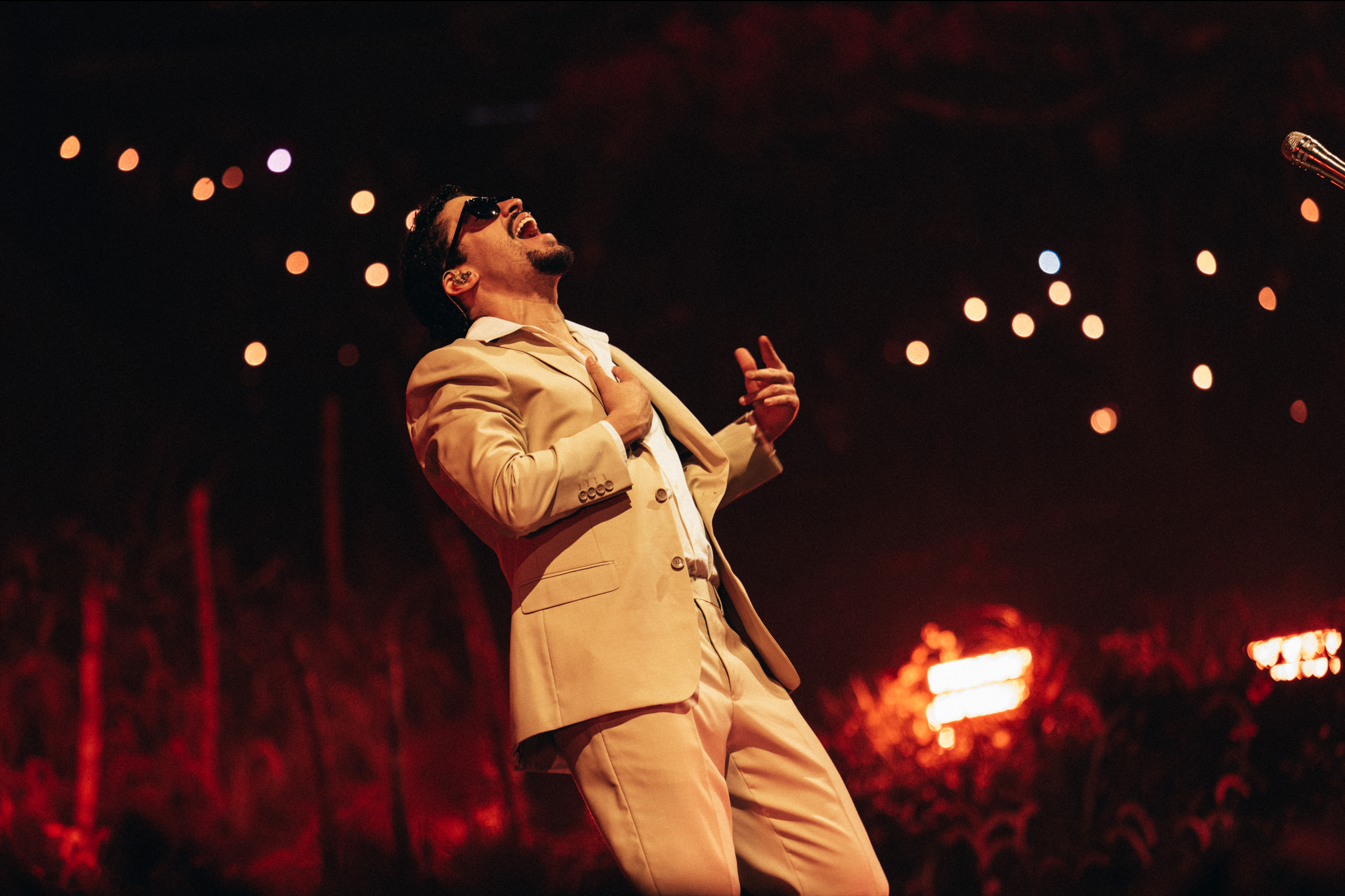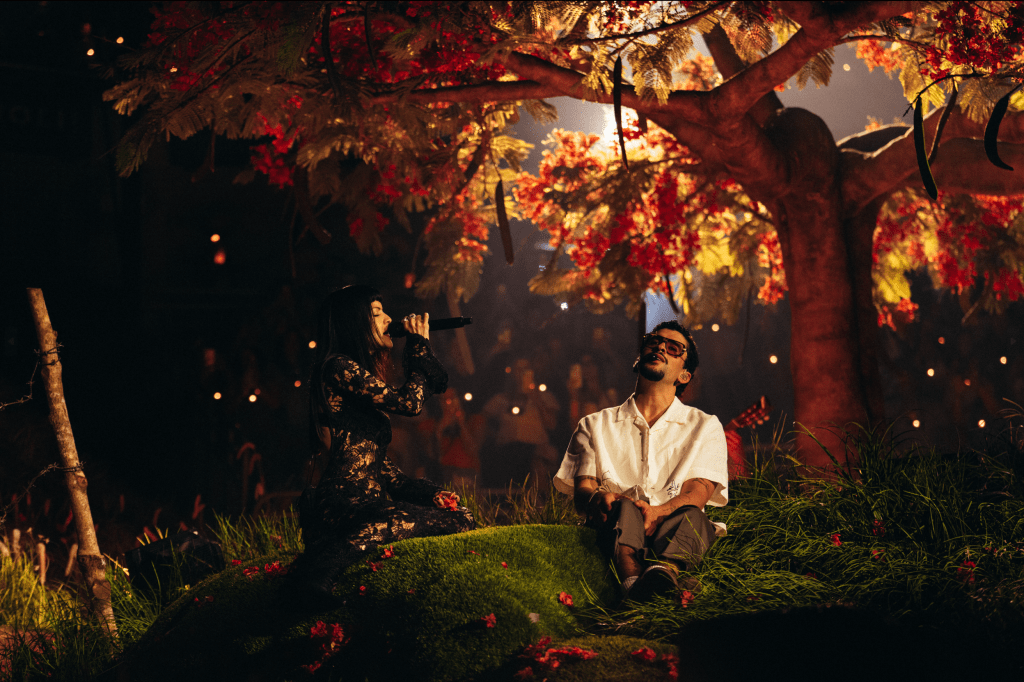
Courtesy of Acoustyle

Audio By Carbonatix
In one of the NFL’s most consequential moves in recent memory, Puerto Rican superstar Bad Bunny has been tapped to headline the Super Bowl LX halftime show — a decision that resonates far beyond football. The announcement comes at a moment when Latinos in the U.S. continue to face heightened scrutiny and hostility under President Donald Trump’s administration.
If you’re somehow unfamiliar with Bad Bunny — real name Benito Antonio Martínez Ocasio — you’d be hard-pressed to prove it. He’s been everywhere in 2025: starring opposite Austin Butler in Darren Aronofsky’s Caught Stealing, charming audiences with back-to-back Saturday Night Live appearances (set to open the upcoming season as both host and performer) and pulling off a record-breaking 30-night residency at El Choli in Puerto Rico. The residency alone turned San Juan into a pilgrimage site, drawing celebrities like DJ Khaled, LeBron James, Penélope Cruz, Kylian Mbappé and Travis Scott.
When news happens, Dallas Observer is there —
Your support strengthens our coverage.
We’re aiming to raise $30,000 by December 31, so we can continue covering what matters most to you. If the Dallas Observer matters to you, please take action and contribute today, so when news happens, our reporters can be there.
At a time when America seems short on larger-than-life entertainers who can dominate across film, television and music while staying true to themselves, Bad Bunny stands out. He’s not just a pop star. He’s a cultural force in the lineage of halftime icons like Michael Jackson, Prince and Kendrick Lamar.
But his selection also lands like a gut punch for the MAGA faithful, the ones who might have preferred to see Kid Rock or Morgan Wallen take the stage. The truth is, being Latino in America right now is difficult, and that’s putting it lightly. Immigration and Customs Enforcement (ICE) encounters are rising, and even legal residents live in fear of harassment. Mexican artists in particular have faced canceled tours and revoked visas, the looming threat of immigration enforcement shadowing their careers.
Bad Bunny – No Me Quiero Ir de Aquí
Meanwhile, Trump’s administration has slashed DEI programs, pushed to rewrite history textbooks and doubled down on policies designed to reassure white America at the expense of everyone else. It’s precisely this climate that influenced Bad Bunny’s decision to center much of his 2025 run in Puerto Rico, where his fans could celebrate free from the hostile atmosphere haunting mainland U.S. cities.
Just an hour before the halftime announcement, Benito teased on Twitter that he’d be willing to do “one show” in the States — a cryptic hint that turned out to be prophetic.
Unfortunately, football fans aren’t the only ones expected to show up to the big game. ICE is set to attend the 2026 Super Bowl, according to Corey Lewandowski, a Department of Homeland Security adviser and former Trump campaign manager. Lewandowski emphasized that under the current administration, no venue—including the Super Bowl—will serve as a safe haven for undocumented immigrants, pledging detention and deportation. He also criticized the NFL for choosing Bad Bunny, accusing him of being anti-American.
“I don’t care if it’s a concert for Johnny Smith or Bad Bunny or anybody else. We’re going to do enforcement everywhere. We are going to make Americans safe. That is a directive from the president. If you’re in this country illegally, do yourself a favor: go home,” Lewandowski said.
While this is clearly another threat, it just goes to show the levels that some politicians will go to spook and antagonize Latino communities.
Bad Bunny’s halftime show won’t just be a performance; it will be a statement. In Trump’s America, it means something when the world’s biggest stage belongs to a Latino artist who refuses to shrink himself to fit into someone else’s narrative.
Let’s rewind to Jan. 5, when Benito dropped his sixth studio album, DeBÍ TiRAR MáS FOToS. For longtime fans, the project felt like a homecoming. After the heavy trap textures of Nadie Sabe Lo Que Va a Pasar Mañana, this was Benito circling back to the sounds that first made him an icon — old-school reggaetón, traditional Puerto Rican rhythms and even flourishes of salsa, which has been making its way back into the mainstream Latin conversation. Across 17 tracks and just over an hour of music, he plants his flag firmly in San Juan, inviting listeners to experience the island not just as a backdrop, but as a character in itself. It’s Benito teaching the world how to add some sazón to their lives, track by track.
“Velda,” the project’s sixth cut, is a perfect example. It’s raw, explicit and sweaty in the way vintage perreo once was, yet refreshed with a 2025 edge. You can’t help but hear echoes of Héctor el Father in its DNA, proof that Benito isn’t just borrowing from the past. He’s reviving it and giving it a new context. Then there’s “Baile Inolvidable,” where he steps into full-blown salsa crooner mode, a modern-day bridge between Marc Anthony and Willie Colón. The track has already sparked a mini cultural movement, with young fans rushing to dance studios to learn the same steps their parents and tíos once showed off at family parties.

Courtesy of Acoustyle
But Benito isn’t just concerned with making people dance. He’s also telling hard truths about his island’s reality. “Turista” turns inward, using a rumored relationship with Kendall Jenner as a metaphor for outsiders exploiting Puerto Rico — tourists snapping up Airbnbs, U.S. developers reshaping neighborhoods and laws tilted to give Americans an edge while locals get priced out. He doubles down on this critique in “Lo Que Le Pasó a Hawaii,” drawing a pointed parallel between Puerto Rico’s colonization and Hawaii’s. Both, he argues, have seen their native populations pushed to the margins while outsiders flourish. These songs are more than music. They’re documentation, protest and cultural preservation all at once.
And that’s what makes Bad Bunny’s halftime slot so significant. The NFL isn’t just booking the biggest star in the world; it’s putting an artist onstage who embodies his homeland’s struggles and resilience wherever he goes. Like Lamar before him, Benito has the hits to turn the halftime show into a 12-minute block party — “Safaera,” “Dákiti,” “Callaíta” and more are practically guaranteed, even if NBC censors will be working overtime. But he’s also proven himself willing to turn entertainment into commentary, to deliver the kind of statement performance that lingers long after the final whistle.
That duality — global superstar and unapologetic Boricua — is exactly why his selection matters. When Latinos are being vilified, having a Puerto Rican artist headline one of the most-watched events in the country is no small thing. It’s visibility. It’s defiance. It’s a reminder that culture doesn’t just adapt to politics — it pushes back against it.
And while Benito is fiercely Puerto Rican, he’s also managed to transcend borders. Collaborations with J Balvin, Cardi B, Drake, Gorillaz, Grupo Frontera and Travis Scott have made him a fixture across genres and languages. He’s part of a wave of Latinos reshaping pop culture alongside acts such as comedian Marcelo Hernández and actor Pedro Pascal, both of whom he’s shared SNL skits with, that audiences of all backgrounds have embraced. In other words, he isn’t just the face of Puerto Rico; he’s a mirror reflecting the future of America itself.
So when Bad Bunny steps onto that halftime stage in 2026, it won’t just be another performance. It’ll be history in real time: a Latino superstar standing at the center of the biggest cultural ritual in the United States, carrying his island and his people with him, whether Trump’s America is ready for it or not.
He’s going to be on that stage representing a fifth of the U.S. population that has given this country countless foods, songs and traditions — things America has adopted so deeply they often forget where they came from. Since the announcement, online outrage has flared up over the idea that “someone who’s not American” will headline the most American of spectacles. Those critics conveniently forget that Puerto Rico is a U.S. territory, one exploited for decades without being granted the full benefits of statehood. Come February, though, we can trust that Benito will deliver our message loud and clear.

Courtesy of Acoustyle